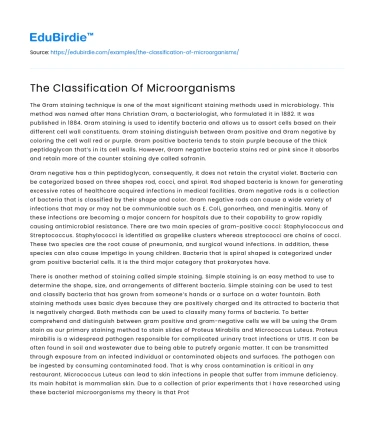The Gram staining technique is one of the most significant staining methods used in microbiology. This method was named after Hans Christian Gram, a bacteriologist, who formulated it in 1882. It was published in 1884. Gram staining is used to identify bacteria and allows us to assort cells based on their different cell wall constituents. Gram staining distinguish between Gram positive and Gram negative by coloring the cell wall red or purple. Gram positive bacteria tends to stain purple because of the thick peptidoglycan that’s in its cell walls. However, Gram negative bacteria stains red or pink since it absorbs and retain more of the counter staining dye called safranin.
Gram negative has a thin peptidoglycan, consequently, it does not retain the crystal violet. Bacteria can be categorized based on three shapes rod, cocci, and spiral. Rod shaped bacteria is known for generating excessive rates of healthcare acquired infections in medical facilities. Gram negative rods is a collection of bacteria that is classified by their shape and color. Gram negative rods can cause a wide variety of infections that may or may not be communicable such as E. Coli, gonorrhea, and meningitis. Many of these infections are becoming a major concern for hospitals due to their capability to grow rapidly causing antimicrobial resistance. There are two main species of gram-positive cocci: Staphylococcus and Streptococcus. Staphylococci is identified as grapelike clusters whereas streptococci are chains of cocci. These two species are the root cause of pneumonia, and surgical wound infections. In addition, these species can also cause impetigo in young children. Bacteria that is spiral shaped is categorized under gram positive bacterial cells. It is the third major category that prokaryotes have.
Save your time!
We can take care of your essay
- Proper editing and formatting
- Free revision, title page, and bibliography
- Flexible prices and money-back guarantee
There is another method of staining called simple staining. Simple staining is an easy method to use to determine the shape, size, and arrangements of different bacteria. Simple staining can be used to test and classify bacteria that has grown from someone’s hands or a surface on a water fountain. Both staining methods uses basic dyes because they are positively charged and its attracted to bacteria that is negatively charged. Both methods can be used to classify many forms of bacteria. To better comprehend and distinguish between gram positive and gram-negative cells we will be using the Gram stain as our primary staining method to stain slides of Proteus Mirabilis and Micrococcus Luteus. Proteus mirabilis is a widespread pathogen responsible for complicated urinary tract infections or UTIS. It can be often found in soil and wastewater due to being able to putrefy organic matter. It can be transmitted through exposure from an infected individual or contaminated objects and surfaces. The pathogen can be ingested by consuming contaminated food. That is why cross contamination is critical in any restaurant. Micrococcus Luteus can lead to skin infections in people that suffer from immune deficiency. Its main habitat is mammalian skin. Due to a collection of prior experiments that I have researched using these bacterial microorganisms my theory is that Proteus mirabilis will be stained a red or pink color due to its gram-negative cell wall arrangement and Micrococcus Luteus will retain the crystal violet color confirming that it has a gram-positive cell wall structure.
The materials that was used in the gram stain was a Bunsen burner, flame loop, deionized water, crystal violet, iodine solution, decolorizer, and safranin. The bacteria sample that was provided in my experiment was Micrococcus Luteus. The beginning of the experiment began with heating the flame loop and adding deionized water to the slide. Heating a flame loop ensures that any contaminating bacteria spores that are left behind are eliminated. Using deionized water will remove any ions that has potential to affect the results of the experiment. A small amount of the bacteria sample on to the center of the slide and smeared it across the entire slide. After the slide air dried for one minute we heat fixed the slide by passing it through the flame three to four times. Heat fixing destroys bacterial enzymes and aide in adhering the bacterial cells to the slide.
Did you like this example?
Make sure you submit a unique essay
Our writers will provide you with an essay sample written from scratch: any topic, any deadline, any instructions.
Cite this paper
-
APA
-
MLA
-
Harvard
-
Vancouver
The Classification Of Microorganisms.
(2022, February 21). Edubirdie. Retrieved March 4, 2025, from https://hub.edubirdie.com/examples/the-classification-of-microorganisms/
“The Classification Of Microorganisms.” Edubirdie, 21 Feb. 2022, hub.edubirdie.com/examples/the-classification-of-microorganisms/
The Classification Of Microorganisms. [online].
Available at: <https://hub.edubirdie.com/examples/the-classification-of-microorganisms/> [Accessed 4 Mar. 2025].
The Classification Of Microorganisms [Internet]. Edubirdie.
2022 Feb 21 [cited 2025 Mar 4].
Available from: https://hub.edubirdie.com/examples/the-classification-of-microorganisms/
copy






 Stuck on your essay?
Stuck on your essay?

